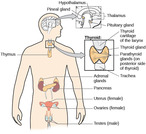
Conditional Remix & Share Permitted
CC BY-NC
By the end of this section, you will be able to:Identify the major glands of the endocrine systemIdentify the hormones secreted by each glandDescribe each hormone’s role in regulating bodily functions
- Subject:
- Psychology
- Social Science
- Material Type:
- Module
- Date Added:
- 07/10/2017